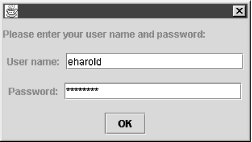Chapter 4. Password Authentication
Hardcoding passwords in source code, as Examples 2-1 and 3-1 do, is a very bad idea to say the least. If a password is required, you should ask the user for it at runtime. Furthermore, when the user types the password, it should not be displayed on the screen. Ideally, it should not even be transmitted in clear text across the network, although in fact many current clients and servers do exactly that.
When you start a mail session, the JavaMail API allows you to provide a javax.mail.Authenticator object that it can use to get the username and password. Authenticator is an abstract class:
publicabstractclassAuthenticatorextendsObject
When the provider needs to know a username or password, it calls back to the getPasswordAuthentication() method in a user-defined subclass of Authenticator. This returns a PasswordAuthentication object containing this information:
protectedPasswordAuthenticationgetPasswordAuthentication()
Tip
These two classes are almost exactly the same as the java.net.Authenticator and java.net.PasswordAuthentication classes. Everything you know about java.net.Authenticator and java.net.PasswordAuthentication is true of javax.mail.Authenticator and javax.mail.PasswordAuthentication. The only thing you have to watch out for is that if you import both java.net.* and javax.mail.* in a class, your source code will have to use fully qualified names like java.net.Authenticator instead of short names like Authenticator.
To add runtime password authentication to your programs, subclass Authenticator and override getPasswordAuthentication() with a method that knows how to securely ask the user for a password. One useful tool for this process is the JPasswordField component from Swing. Example 4-1 demonstrates a Swing-based Authenticator subclass that brings up a dialog to ask the user for their username and password.
importjavax.mail.*;importjavax.swing.*;importjava.awt.*;importjava.awt.event.*;publicclassMailAuthenticatorextendsAuthenticator{privateJDialogpasswordDialog=newJDialog(newJFrame(),true);privateJTextFieldusernameField=newJTextField(20);privateJPasswordFieldpasswordField=newJPasswordField(20);privateJButtonokButton=newJButton("OK");publicMailAuthenticator(){this("");}publicMailAuthenticator(Stringusername){JLabelmainLabel=newJLabel("Please enter your username and password: ");JLabeluserLabel=newJLabel("Username: ");JLabelpasswordLabel=newJLabel("Password: ");Containerpane=passwordDialog.getContentPane();pane.setLayout(newGridLayout(4,1));pane.add(mainLabel);JPanelp2=newJPanel();p2.add(userLabel);p2.add(usernameField);usernameField.setText(username);pane.add(p2);JPanelp3=newJPanel();p3.add(passwordLabel);p3.add(passwordField);pane.add(p3);JPanelp4=newJPanel();p4.add(okButton);pane.add(p4);passwordDialog.pack();ActionListenerlistener=newHideDialog();okButton.addActionListener(listener);usernameField.addActionListener(listener);passwordField.addActionListener(listener);}classHideDialogimplementsActionListener{@OverridepublicvoidactionPerformed(ActionEventevent){passwordDialog.setVisible(false);}}publicPasswordAuthenticationgetPasswordAuthentication(){passwordDialog.setVisible(true);// getPassword() returns an array of chars for security reasons.// We need to convert that to a String for// the PasswordAuthentication() constructor.Stringpassword=newString(passwordField.getPassword());Stringusername=usernameField.getText();// Erase the password in case this is used again.// The provider should cache the password if necessary.passwordField.setText("");returnnewPasswordAuthentication(username,password);}}
Most of this code is just for handling the GUI. Figure 4-1 shows the rather simple dialog box this produces.
Interestingly, JPasswordField takes more pains to be secure than PasswordAuthentication does. JPasswordField stores passwords as an array of chars so that when you’re done with the password, you can overwrite it with nulls. This means the password exists in memory for less time and the virtual memory system is less likely to swap the program out to disk and leave the password there in clear text. However, PasswordAuthentication stores passwords as strings, which are immutable and therefore are more likely to be written to disk in a VM swap.
Modifying the POP client to support this style of authentication is straightforward, as Example 4-2 demonstrates. We replace the hardcoded username and password with nulls and pass an instance of MailAuthenticator as the second argument to connect(). The only other change is that we call System.exit() at the end of the main() method, since the program will no longer exit when the main() method returns once the event dispatch thread has been started.
importjavax.mail.*;importjava.io.IOException;importjava.util.*;publicclassSecurePOP3Client{publicstaticvoidmain(String[]args){Propertiesprops=newProperties();Stringhost="utopia.poly.edu";Stringprovider="pop3";try{// Connect to the POP3 serverSessionsession=Session.getInstance(props,newMailAuthenticator());Storestore=session.getStore(provider);store.connect(host,null,null);// Open the folderFolderinbox=store.getFolder("INBOX");if(inbox==null){System.out.println("No INBOX");System.exit(1);}inbox.open(Folder.READ_ONLY);// Get the messages from the serverMessage[]messages=inbox.getMessages();for(inti=0;i<messages.length;i++){System.out.println("------------ Message "+(i+1)+" ------------");messages[i].writeTo(System.out);}// Close the connection// but don't remove the messages from the serverinbox.close(false);store.close();}catch(MessagingException|IOExceptionex){ex.printStackTrace();}// since we brought up a GUI returning from main() won't exitSystem.exit(0);}}
Get JavaMail API now with the O’Reilly learning platform.
O’Reilly members experience books, live events, courses curated by job role, and more from O’Reilly and nearly 200 top publishers.


